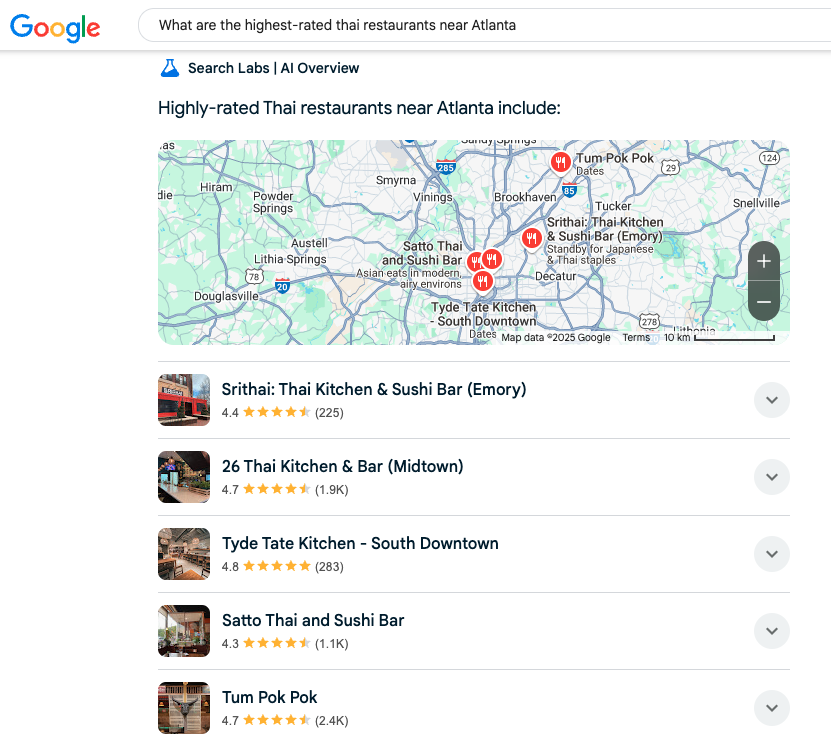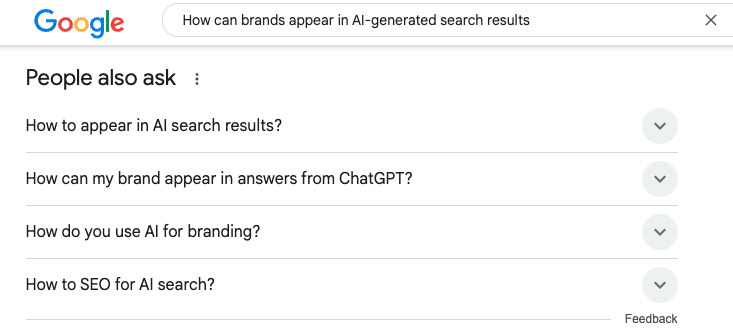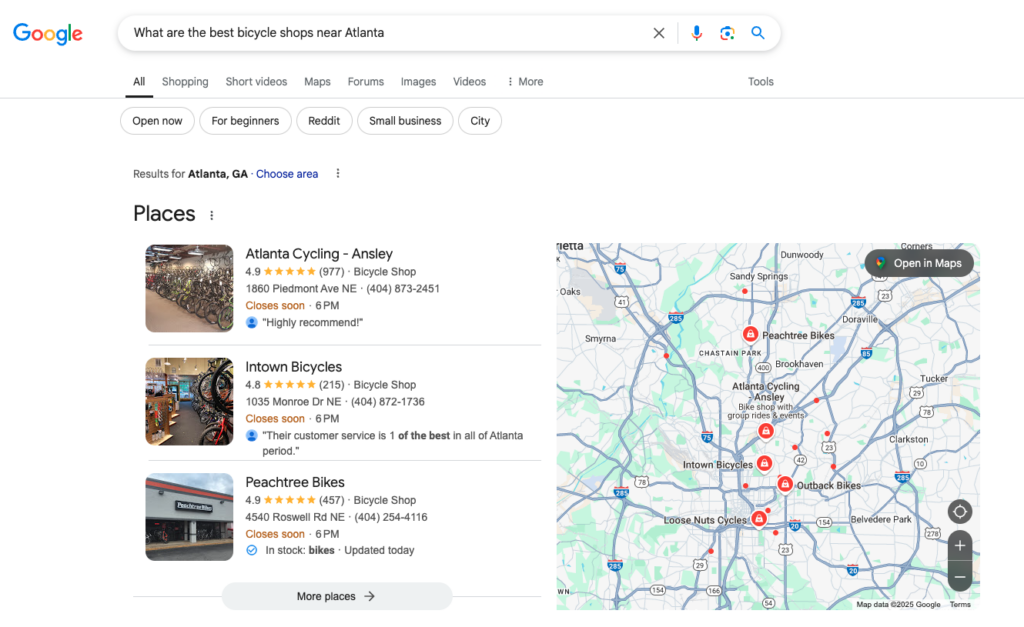The AI Search Revolution Is Here. Is Your Business Prepared?
Artificial Intelligence (AI) is fundamentally altering how consumers search, shop, and engage with businesses online. For business owners and Chief Marketing Officers (CMOs), this shift is not just a trend—it’s a seismic transformation in digital marketing and search engine optimization (SEO). This article offers an AI search strategy that CMOs and business owners can use to lift SEO rankings and site traffic.
AI-driven platforms like Google Gemini, ChatGPT, and Microsoft Copilot are becoming the new gatekeepers of online information. They’re reshaping how customers interact with digital content, delivering instant, conversational answers that often bypass traditional search engine result pages.
A Harvard Business Review report notes that AI agents are informing purchase decisions and beginning to execute them autonomously. As this becomes more normalized, brands not integrated into AI-optimized ecosystems risk losing visibility and sales.
If your business isn’t showing up in these AI-powered interactions, it’s not just invisible — it’s irrelevant.
What This Article Will Teach You
- Why AI search is replacing traditional SEO strategies
- The impact of AI on your brand’s discoverability and traffic
- Ten proven strategies to future-proof your digital presence
- How to position your business as a trusted source in AI search
- How to measure and track your AI search visibility
What Is AI Search?
AI search refers to the use of artificial intelligence tools and algorithms to interpret, deliver, and sometimes even summarize online information in response to user queries. Unlike traditional search engines, which rely heavily on keyword matching and ranking signals, AI search engines interpret intent, context, and semantics.
AI search doesn’t just return a list of links — it offers complete answers, curated insights, or even personalized recommendations based on large language models (LLMs) and contextual learning.
Examples include:
- ChatGPT or Google Gemini summarizing an entire website’s content to answer a user’s question
- Voice assistants like Siri or Alexa recommend services based on past behavior
- AI agents booking services or making purchases automatically on behalf of users
1. Optimize for Conversational Search
AI-powered search tools are designed to understand and respond to natural language queries. Instead of typing “best local dentist,” consumers now ask, “Who’s the highest-rated dentist near me that accepts Delta Dental and offers same-day crowns?”
This shift requires businesses to anticipate and match questions in how customers ask them.
How to adapt:
- Use natural language and long-tail keywords
- Develop content that answers specific customer questions
- Include FAQ sections targeting “how,” “what,” “why,” and “where” questions
- Add user intent–driven headlines such as “What’s the best option for…”
Example:
Use a heading like: “What are the highest-rated Thai restaurants near Atlanta?” and answer it concisely beneath.

2. Implement Structured Data Markup
Schema markup helps search engines and AI tools better understand your content. This increases your chances of being featured in AI Overview summaries and Google’s “People Also Ask” (PAA) results.
According to IO Digital, structured data also influences how your brand appears in voice search, which is increasingly powered by AI agents.
Tools to help: Google Structured Data Markup Helper, Yoast SEO, Schema Pro
Best practices:
- Use schema for product pages, FAQs, reviews, and articles
- Validate with Google’s Rich Results Test
- Add local business, organization, and review schema to support trustworthiness
- Implement FAQ page schema to answer common queries directly in SERPs
3. Focus on High-Quality, Authoritative Content
AI algorithms favor content that demonstrates Experience, Expertise, Authoritativeness, and Trust (E-E-A-T).
According to Techspective, one of the most significant changes in AI search is the prioritization of content that is not just well-written but backed by reliable data and expert opinion.
Tips:
- Publish in-depth, well-researched content with supporting data
- Keep pages updated with fresh statistics and industry insights
- Highlight the credentials of content creators and cite credible sources
- Link out to government, academic, or high-authority third-party sources
4. Target Google’s “People Also Ask” Section
Google’s PAA section is a valuable opportunity to appear directly in front of engaged users who are already asking related questions.
How to rank there:
- Use headers in the form of questions (H2 or H3)
- Answer each question in 2-3 concise sentences
- Use bullet points where appropriate
- Provide clear, direct, fact-based answers
- Refresh your content regularly to maintain rankings
- How is AI changing digital marketing?
- What does AI search mean for local businesses?
- How can brands appear in AI-generated search results?

5. Leverage New Consumer Trust in AI Search
According to the 2025 Consumer Adoption of AI Report:
- 41% of consumers trust Gen AI search results more than paid search ads
- Only 15% trust AI less than paid ads
- Among AI users, 68% trust the information provided by AI tools
Demographic differences:
- Men (44%) trust AI more than women (37%)
- Younger users (18-30) are more AI-trusting than those 50+
- US/UK consumers are more open to AI than Canadian/Australian audiences
Source: Forbes, March 2025 — AI Search Results More Trusted Than Ads: What CMOs Need to Know
Implication:
Content that is optimized to appear in AI answers could have a more long-term brand impact than traditional PPC.
6. Create Content AI Tools Can Parse
AI tools pull from web content differently than traditional search engines. They prioritize clarity, structure, and verifiability.
Optimize with:
- Short paragraphs (2-4 sentences)
- Clear headings every 200-300 words
- Bullet points and numbered lists
- Use authoritative sources and avoid vague or sensational language
- Ensure mobile and desktop layouts are both clean and accessible
Bonus Tip: Avoid JavaScript-heavy pages. AI tools may struggle to interpret client-side rendering.
7. Enhance Local SEO and Online Listings
AI often delivers hyper-local results tailored to the user’s location and query intent. Local businesses primarily must ensure they’re being read and ranked correctly by AI.
Checklist:
- Consistent NAP (Name, Address, Phone) across platforms
- Up-to-date Google Business Profile with FAQs and services
- Fresh customer reviews and responses from owners
- Use Google’s Q&A feature and populate it with helpful information
- Claim listings on all major directories (Yelp, Bing Places, Apple Maps)

8. Prioritize Mobile and Voice Search Optimization
With over 50% of searches now occurring on mobile and a growing portion via voice assistants, your site needs to be built for both.
Optimize for:
- Fast page loads and mobile-responsive design
- Conversational voice-friendly keywords (“What’s the best… near me?”)
- Text alternatives for media
- Use of AMP pages and lazy loading for speed
- Add alt text and ARIA labels to support accessibility
9. Embrace AI-Driven Personalization and Automation
AI is also a tool for marketers, not just a challenge. Use AI internally to:
Applications:
- Create dynamic landing pages based on user behavior
- Segment email lists and automate content personalization
- Run predictive analytics to identify purchase patterns
- Use AI chatbots for customer support and lead capture
- Track cross-channel engagement to adjust messaging in real time
10. Stay Ahead of AI Trends and Algorithm Updates
Implementing an AI search strategy for business owners and CMOs starts with optimizing your site for natural, conversational queries that AI understands. AI search is not a one-time project — it’s a constant evolution. According to Level Agency, businesses that adapt their strategies quarterly outperform those that revise only once or twice a year.
How:
- Follow Google’s Search Central blog and OpenAI/Anthropic updates
- Use tools like Clearscope or MarketMuse for content scoring
- Re-audit and re-optimize your top content every 3-6 months
- Benchmark against competitors to identify SEO gaps
How to Measure Your AI Search Visibility
Unlike traditional SEO, where the ranking position is clear, AI search visibility is more nuanced. To evaluate your effectiveness:
Track using:
- Branded mention monitoring (tools like Brand24 or SEMrush)
- Featured Snippet tracking (Ahrefs, Moz, or SEMrush)
- PAA and FAQ appearances (via tools like AlsoAsked and KeywordTool.io)
- Voice search audits (test answers via smart assistants)
- Review Search Console data for impressions on question-based queries
Summary: Your AI Search Strategy for Business Owners and CMOs
- AI is reshaping search, marketing, and customer acquisition
- Gen AI is gaining trust faster than paid media
- Structured, conversational content wins visibility
- Success measurement must adapt to include visibility in summaries, voice results, and chatbots
- Those who embrace and integrate AI now will lead tomorrow
Ready to Future-Proof Your Marketing Strategy?
AIS Media has helped businesses dominate digital search for nearly 20 years. We understand how to adapt traditional SEO to the rapidly evolving AI landscape.
Let’s work together to boost your visibility, drive more qualified traffic, and turn search into sales.
👉 Schedule Your Free Consultation
A forward-looking AI search strategy for business owners and CMOs involves structured content, measurable visibility, and ongoing adaptation to AI-driven technologies.
Together, we’ll ensure your business gets found—even in the AI era.

